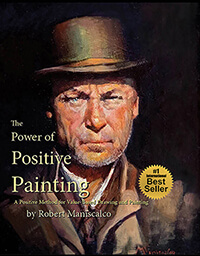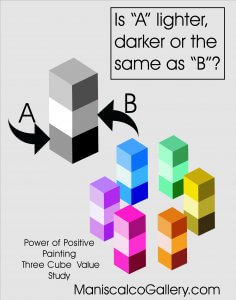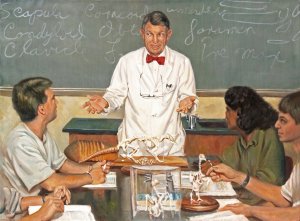 People thought I was crazy trying to create a system that would make drawing and painting available to anyone who applied themselves, what I call the “democritization” of art. That was the goal, to distil the processes of master realists and combine them with the power of positive thinking. There is an ancient secret, claimed to have been known by the great thinkers and leaders in history, that says what you focus on will manifest itself in your life.
People thought I was crazy trying to create a system that would make drawing and painting available to anyone who applied themselves, what I call the “democritization” of art. That was the goal, to distil the processes of master realists and combine them with the power of positive thinking. There is an ancient secret, claimed to have been known by the great thinkers and leaders in history, that says what you focus on will manifest itself in your life.
I was first introduced to “The Law of Attraction” by Jan Titsworth, who like many, struggled with representational drawing and painting. She convinced me of the potential for combining the Reilly Method with a more holistic approach. As a teacher I realized quickly that people literally doubted their own eyes. They believed art was impossible and I could see them doing everything they could to make that true for themselves. Jan helped me distil the complex system into simple concepts that even the most visually challenged could comprehend and apply effectively. She and I developed the Power of Positive Painting Instructional Video in 1995, the first ever instructional video for portrait painting. It is still part of many video libraries. The Portrait is a later version of the original video, which gathered a ton of information and experiences and packed it into a full six hours of video instruction.
Many books have been written about the Reilly Method. The problem is, these books tend to be overly complicated, partly, I think, to honor the man himself, who believed all observable nature could be quantified, much the way musicians devised a written notation system they could use to communicate with one another. Reilly wanted do the same with the visual spectrum. So his disciples created endless graphs and charts to explain and quantify every minutia that might occur in the visual realm, which made for some mind numbing reading, as I researched The PPP.
But I think Reilly’s intention was to simplify the process, distilling the essence of what the masters used to create history’s greatest works of art. The PPP does not lay too much information at the foot of the artist. Without condescension, I think it is accurate to say most great artists resist approaching art as an academic subject. I’m one of them. Why? Because, at the end of the day, art is not a mental process. It is an emotional one. So, The PPP gives you just what you need to get your juices flowing. No more and no less. It is not an attempt at a comprehensive guide to the Reilly system. It is not esoteric. It is not theoretical. But neither is it overly simplistic. It is a practical guide to representational drawing and painting. I think it gets to the heart of the Reilly method, which produced many of the greatest realists of the twentieth century.
The PPP came about after 40 years of my teaching the system and honing the method. It is dedicated to my father, Joseph Maniscalco, one of Reilly’s top disciples, who intended to write his version of the Reilly system and just never got around to it. The pandemic sort of created an opening for me to put down into words and images, the process I learned from my father, that he learned from his teacher, the great Frank Reilly.
 The PPP focuses on two simple ideas: 1) all shapes are connected and related to one another and 2) light reveals form. Understanding how values work is actually so simple that budding artists often believe at first that I’m pulling a fast one on them. It can’t be that simple. Can it? I think it is human nature to make things more complicated than they need to be. Artists are no exception.
The PPP focuses on two simple ideas: 1) all shapes are connected and related to one another and 2) light reveals form. Understanding how values work is actually so simple that budding artists often believe at first that I’m pulling a fast one on them. It can’t be that simple. Can it? I think it is human nature to make things more complicated than they need to be. Artists are no exception.
The PPP meets people where they are. I found that what art students needed most was to develop confidence in their honest observational skills. Budding artists have a difficult time believing that they can be successful at something they have convinced themselves is utterly complex and ineffable. It is by believing art is beyond them, that it has become true for them. I find most of my time teaching is spent convincing people to trust what is right in front of them. What makes drawing and painting complicated is that we simply don’t believe the shapes and forms, those abstract miracles, that are actually right in front of us. So we take the wrong kinds of liberties.
My job is to convince people that making a picture really is simple. Because, if you believe and invest yourself in the simplicity of the system, I know it will transform your work, as it has hundreds who have applied The PPP. It is the idea that art must be complex that interferes with our being able to see nature honestly. So, my goal is to get you hyper focused on a few simple processes. I say in the book, “art is what happens while you are thinking about something else,” namely accurate values and finding and expressing the connections between shapes. That’s where we need to place our focus on. That is the secret to learning to draw and paint representationally.
 The answer to most any question we have about what to do next can be found in the model (or whatever we are looking at that we want to draw or paint). One of my mantras, “the model is always right,” says it all. The PPP teaches us to see honestly. With some practice, investing in the exercises in the book, which teach us how to abstract (distill) shapes and forms into their essence, The PPP will provide you the necessary eye training you need to succeed.
The answer to most any question we have about what to do next can be found in the model (or whatever we are looking at that we want to draw or paint). One of my mantras, “the model is always right,” says it all. The PPP teaches us to see honestly. With some practice, investing in the exercises in the book, which teach us how to abstract (distill) shapes and forms into their essence, The PPP will provide you the necessary eye training you need to succeed.
Confidence as an artist comes with breaking down the process, dealing with each piece of the puzzle, then moving and combining them into more involved processes. Soon, almost without realizing it, the book will have you making convincing pictures. We learn, for instance, that the key to making things look 3-D is committing ourselves to separating light and shadow values. We learn that making something look 3-D has nothing to do with color. It doesn’t even have to do with drawing. It is all about the careful manipulation of values. The book builds on specific skills, like a musician and her scales, which must be practiced intentionally. With patient practice comes mastery.
The PPP provides a clear, direct path for success. If you are willing to work hard doing what you love, then The PPP is the right book for you.

 Would you like to get inspiration in your inbox, rather than ads for more stuff? Welcome to ManiscalcoGallery.com
Would you like to get inspiration in your inbox, rather than ads for more stuff? Welcome to ManiscalcoGallery.com